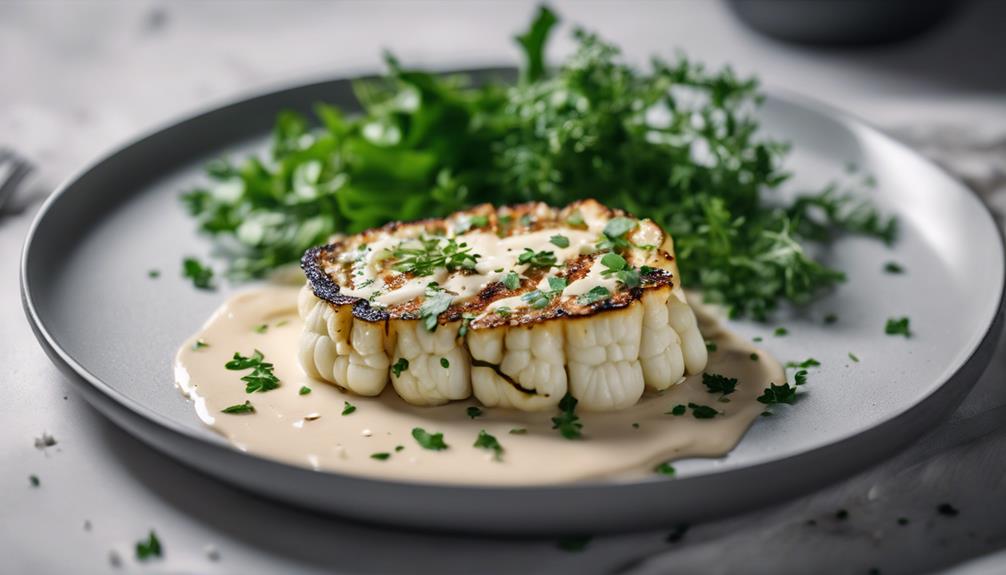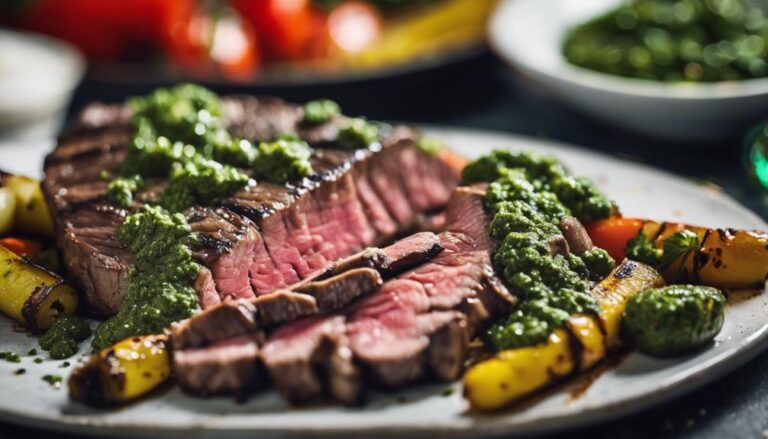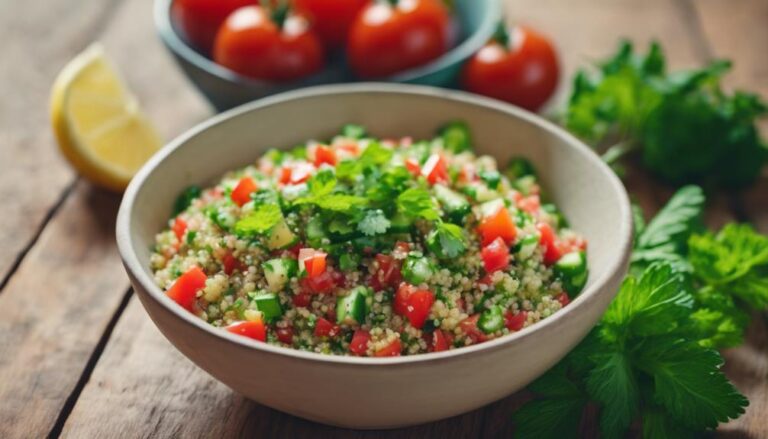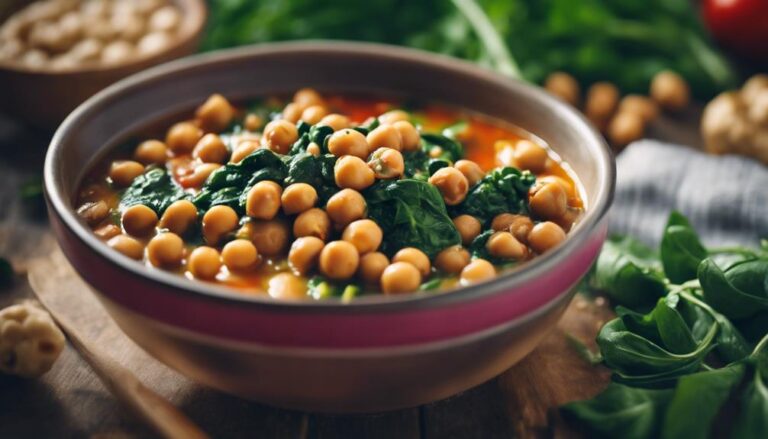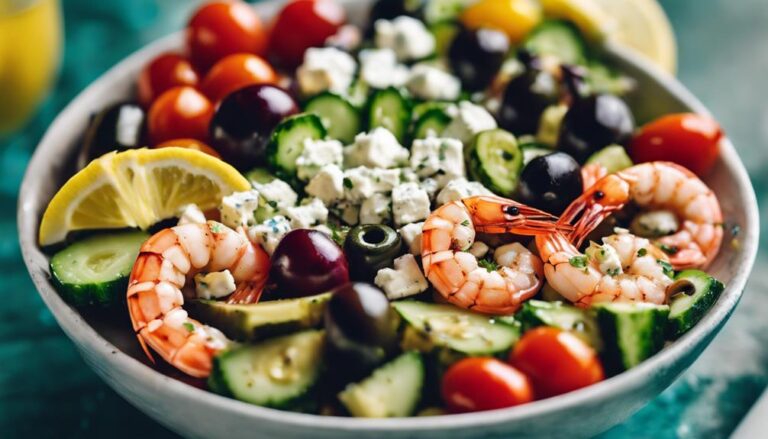Sous Vide Cauliflower Steak With Tahini Sauce
Savor a gourmet experience by preparing sous vide cauliflower steak with tahini sauce. To start, season thick cauliflower slices with salt, pepper, and olive oil, then vacuum-seal and cook in a water bath at 185°F for about an hour. While it cooks, blend tahini, lemon juice, garlic, and water for a creamy sauce. Once the cauliflower is tender, sear it briefly for a golden crust. Plate the steak, drizzle with the tahini sauce, and garnish with fresh herbs for an exquisite dish bursting with flavors. Master this technique, and elevate your culinary skills with each succulent bite.
What You Will Learn Here
- Sous vide cooking ensures precise temperature control for perfectly cooked cauliflower steaks.
- Tahini sauce adds a creamy, nutty flavor that complements the earthy taste of cauliflower.
- Marinate cauliflower steaks in tahini sauce before sous vide cooking for enhanced flavor infusion.
- Sous vide method helps retain the nutrients and natural flavors of cauliflower during cooking.
- Finish by searing the sous vide cauliflower steaks for a golden crust before serving with tahini sauce.
Cauliflower's Ancient Culinary Roots
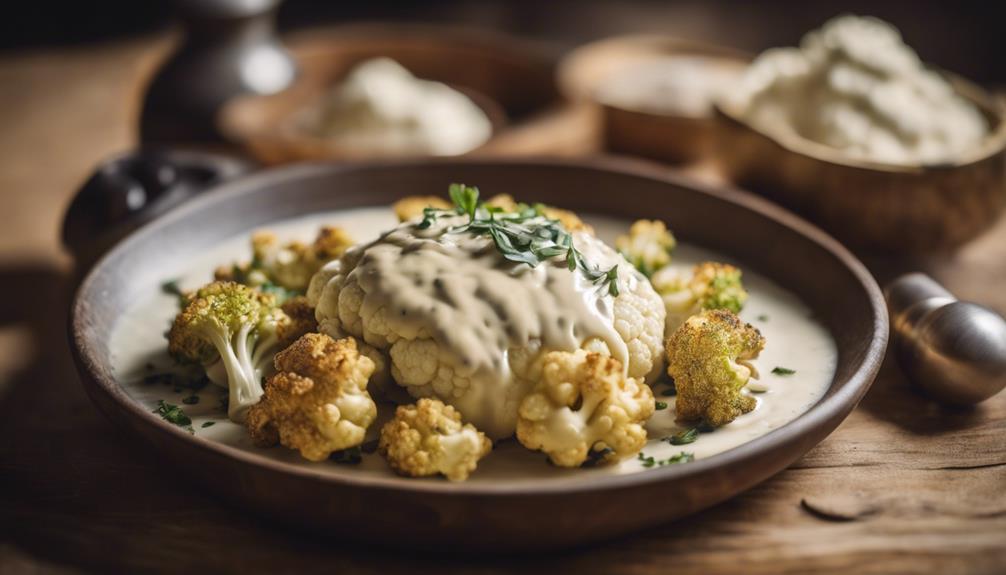
Cauliflower, a versatile vegetable, has ancient culinary roots that date back centuries.
Through history, cauliflower has been utilized in various traditional dishes across different cultures.
Exploring the historical culinary uses of cauliflower sheds light on its significance in gastronomy.
Origins of Cauliflower
Tracing back through history, discovering the ancient culinary roots of cauliflower reveals a rich tapestry of cultural influences and gastronomic evolution. Cauliflower, a member of the Brassica oleracea species, has been cultivated for over 2,000 years. Its origins can be traced to the Mediterranean region, where it was initially grown in Ancient Egypt and later spread to Europe and Asia. Over time, cauliflower became a staple in various cuisines worldwide, adapting to local flavors and cooking techniques.
In today's culinary landscape, cauliflower is celebrated for its versatility. From cauliflower rice to roasted cauliflower steaks, modern recipes showcase its ability to transform into a wide range of dishes. Additionally, cauliflower boasts numerous health benefits, being a good source of vitamins C and K, as well as fiber and antioxidants. Its low-calorie content and high nutrient density make it a popular choice for health-conscious individuals looking to add more vegetables to their diet. Whether roasted, mashed, or turned into a flavorful side dish, cauliflower continues to captivate taste buds and nourish bodies with its ancient culinary heritage and modern culinary appeal.
Historical Culinary Uses
Exploring the historical culinary uses of cauliflower reveals a fascinating journey through time, showcasing its adaptability and enduring presence in various cuisines. Cauliflower holds significant cultural symbolism in different societies, often representing purity, fertility, or even transformation due to its white color and unique appearance.
Throughout history, cauliflower has been depicted in art, capturing its beauty and versatility in paintings, sculptures, and other artistic mediums. These historical depictions not only showcase the vegetable's aesthetic appeal but also highlight its cultural significance in different eras.
Cauliflower has been a staple ingredient in traditional dishes across many cultures, with each region infusing its unique flavors and cooking techniques into recipes. From ancient civilizations to modern-day culinary practices, cauliflower has remained a versatile and sought-after vegetable due to its ability to absorb flavors and complement a wide range of ingredients.
Its historical culinary uses reflect a deep-rooted appreciation for this vegetable's adaptability and nutritional value, making it a timeless ingredient in global cuisine.
Traditional Cauliflower Dishes
After uncovering the historical significance and cultural importance of cauliflower, let's now journey into its ancient roots by exploring traditional dishes that have stood the test of time. Cauliflower recipes have been passed down through generations, showcasing the versatility of this cruciferous vegetable in various cuisines worldwide. From comforting cauliflower cheese to spicy Indian aloo gobi, cauliflower has been a staple ingredient in traditional dishes across cultures.
In addition to their delicious flavors, cauliflower recipes offer numerous health benefits. This low-calorie vegetable is packed with vitamins, minerals, and antioxidants that support overall well-being. Whether roasted, steamed, or mashed, cauliflower retains its nutritional value, making it a popular choice for health-conscious individuals looking to add more vegetables to their diet.
Versatile Cauliflower Steak Ingredients
For the perfect cauliflower steak, select fresh cauliflower heads that are firm and free of blemishes. When preparing cauliflower steak, you'll want to gather a few key ingredients to enhance the flavors and textures. Here are some versatile options to contemplate:
- Herbs and Spices: Experiment with different herbs like rosemary, thyme, or spices such as smoked paprika or cumin to add depth to your cauliflower steak.
- Citrus Zest: Adding a touch of citrus zest from lemon or orange can brighten up the flavors and bring an invigorating twist to your dish.
- Nuts and Seeds: Toasted almonds, sesame seeds, or pine nuts can provide a delightful crunch and nutty flavor to complement the cauliflower.
- Vinegar or Lemon Juice: A splash of vinegar or a squeeze of fresh lemon juice can help balance the richness of the cauliflower steak and tahini sauce.
These ingredients can elevate your cauliflower steak, adding layers of flavor and texture to create a delicious and satisfying dish.
Tasty Cauliflower Steak Variations
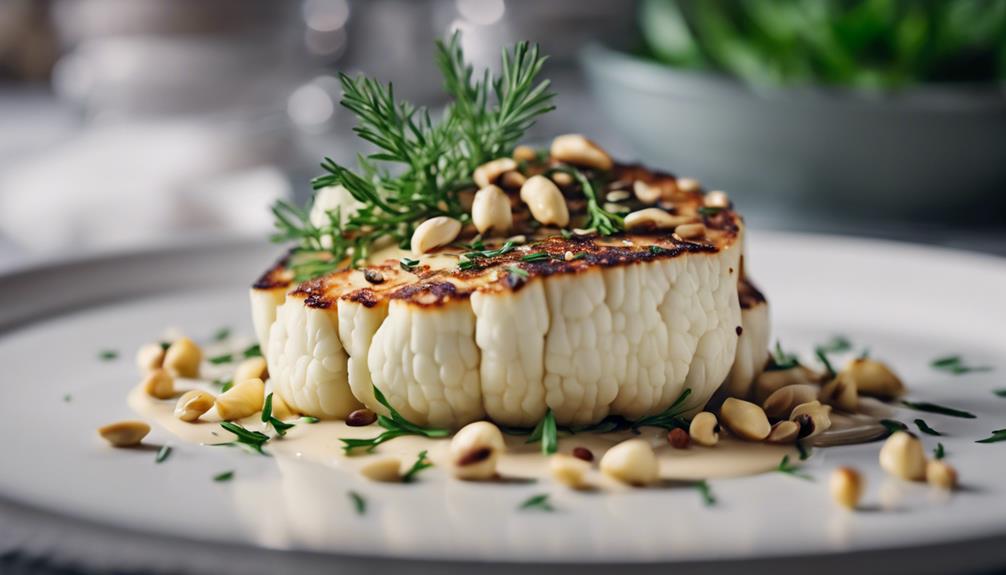
Explore exciting variations of cauliflower steak to elevate your culinary experience.
Try the Tahini-Drizzled Cauliflower Steak for a nutty twist, or opt for a Savory Cauliflower Steak Medley for a burst of flavors.
For a fresh take, indulge in a Cauliflower Steak With Pesto Crust that promises a delightful herbal kick.
Tahini-Drizzled Cauliflower Steak
Indulge in the rich flavors of tahini-drenched cauliflower steak for a delectable twist on this classic dish. If you enjoy the nutty taste of tahini, this variation will surely tantalize your taste buds.
Here are some ways to enhance your cauliflower steak with creamy tahini:
- Tahini Drizzle: After roasting the cauliflower steak to perfection, drizzle a generous amount of creamy tahini sauce over the top for a luscious finish.
- Sesame Seed Garnish: Sprinkle toasted sesame seeds on top of the tahini for added texture and a burst of nutty flavor.
- Lemon Zest: Grate some fresh lemon zest over the tahini-drenched cauliflower steak to brighten the dish with a hint of citrus.
- Fresh Herbs: Garnish with chopped parsley or cilantro to add a pop of color and freshness to your tahini-covered cauliflower steak.
These simple additions will elevate your cauliflower steak, creating a delightful and satisfying meal that's sure to impress your palate.
Savory Cauliflower Steak Medley
Discover an array of tantalizing cauliflower steak variations in this savory medley that promises to elevate your dining experience. Here are some tips to enhance your cauliflower steak journey:
- Roasting Techniques: Experiment with different roasting methods like high-heat roasting for a crispy exterior or low and slow roasting for a tender texture. Adjust cooking times to achieve your desired level of doneness and flavor intensity.
- Flavor Profiles: Infuse your cauliflower steaks with diverse flavors by marinating them in spices such as cumin, smoked paprika, or garlic powder before roasting. Consider adding a drizzle of balsamic glaze or a sprinkle of nutritional yeast for an extra burst of taste.
- Seasoning Options: Explore various seasoning blends like lemon herb, Mediterranean-inspired, or spicy Cajun to create unique and exciting flavor combinations that will tantalize your taste buds.
- Presentation Ideas: Elevate the visual appeal of your cauliflower steaks by garnishing them with fresh herbs, toasted nuts, or a sprinkle of flaky sea salt. Serve them on a bed of creamy mashed potatoes or alongside a vibrant salad for a stunning presentation that delights both the eyes and the palate.
Cauliflower Steak With Pesto Crust
Enhance your cauliflower steak experience with a delectable Pesto Crust that adds a burst of flavor to every bite. When you want to elevate your grilled cauliflower game or add a flavorful twist to your roasted vegetables, this Cauliflower Steak With Pesto Crust recipe is the perfect choice. Here are four ways to make this delicious variation:
- Prepare the Pesto: Blend fresh basil, pine nuts, Parmesan cheese, garlic, and olive oil to create a vibrant and aromatic pesto sauce.
- Coat the Cauliflower: Spread a generous layer of the homemade pesto on each side of your cauliflower steaks, ensuring they're evenly coated for maximum flavor.
- Roast to Perfection: Roast the cauliflower steaks in the oven until they're tender on the inside and crispy on the outside, allowing the pesto crust to infuse the cauliflower with its rich flavors.
- Serve and Enjoy: Plate your grilled cauliflower steaks alongside a medley of roasted vegetables for a colorful and satisfying dish that will impress your taste buds.
Searing for Perfect Cauliflower Steak
When searing your cauliflower steak, focus on techniques like achieving a nice crust.
Controlling the searing temperature is essential to prevent burning.
The Maillard reaction is key for developing those delicious flavors.
Searing Techniques
To achieve the perfect sear on your cauliflower steak, start by preheating a cast-iron skillet over medium-high heat. When it comes to sous vide searing, there are various alternative methods you can use to enhance the flavor and texture of your cauliflower. Once your skillet is hot, add a small amount of oil to prevent sticking and carefully place your cauliflower steak in the pan. Let it sear undisturbed for a few minutes until a golden-brown crust forms.
For best results, consider experimenting with flavorful seasonings like smoked paprika, garlic powder, or a pinch of cayenne pepper to elevate the taste profile of your cauliflower steak. As you sear, resist the temptation to move the steak around too much; allowing it to sit will develop a delicious caramelized exterior. Remember to adjust the heat if needed to prevent burning while ensuring a thorough sear. These searing techniques will help you achieve a beautifully caramelized cauliflower steak that's both visually appealing and bursting with flavor.
Temperature Control
For precise temperature control when searing your cauliflower steak, make sure the cast-iron skillet is preheated to the optimal temperature for achieving a golden-brown crust. Sous vide cooking offers precise temperature control, ensuring your cauliflower steak is perfectly cooked throughout. This method allows you to achieve consistent results, making it easier to cook the steak evenly.
In terms of cauliflower nutrition, this cruciferous vegetable is packed with health benefits. Cauliflower is rich in vitamins, minerals, and antioxidants. It's low in calories but high in fiber, making it a great addition to a healthy diet.
When searing your cauliflower steak, maintaining the right temperature is essential for achieving a crispy exterior while keeping the interior tender. By using a sous vide technique before searing, you can control the doneness of the cauliflower precisely.
Maillard Reaction
To enhance the flavor and texture of your cauliflower steak, achieving a perfect Maillard reaction through searing is essential. The Maillard reaction is a chemical reaction that occurs between amino acids and reducing sugars when exposed to heat. This reaction is vital in developing the rich flavor and enticing aroma of your cauliflower steak.
When you sear your cauliflower steak, the surface browns and caramelizes, creating a depth of flavor that enhances the overall taste experience. The browning that takes place during the Maillard reaction not only adds a delicious nutty flavor but also contributes to the visual appeal of your dish.
Moreover, searing your cauliflower steak helps in texture enhancement through caramelization. The outer layer crisps up, providing a delightful contrast to the tender interior. This combination of textures elevates the eating experience, making each bite satisfying and enjoyable.
Final Thoughts
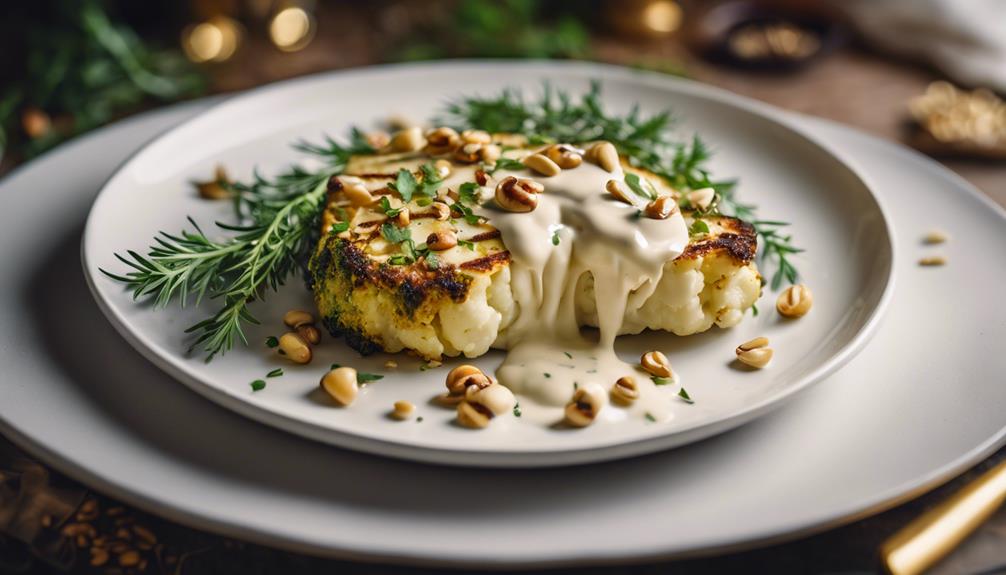
Consider reflecting on the overall cooking experience and how the flavors came together in this sous vide cauliflower steak with tahini sauce recipe. The benefits of using sous vide cooking are evident in the cauliflower steak's tenderness and the way it absorbs the marinade flavors thoroughly. This method allows for precise temperature control, ensuring a consistent result every time. The flavor enhancement achieved by marinating the cauliflower before sous vide cooking adds depth to the final dish. Experimenting with different seasonings and textures can elevate the dish further, offering a personalized touch to suit your taste preferences.
When trying this recipe, take note of how the tahini sauce complements the earthy flavors of the cauliflower, providing a creamy and nutty contrast. The Maillard reaction achieved through searing the cauliflower after sous vide cooking adds a desirable caramelized flavor profile. Overall, this dish showcases the versatility of cauliflower and how sous vide cooking can transform this humble vegetable into a gourmet experience. Enjoy exploring new seasonings and textures to create a dish that suits your palate perfectly.
Frequently Asked Questions
Can I Use Frozen Cauliflower for This Recipe?
Yes, you can use frozen cauliflower for this recipe. However, keep in mind that fresh cauliflower might yield a slightly better texture compared to frozen. Thaw and pat the cauliflower dry before sous viding for best results.
Is There a Substitute for Tahini in the Sauce?
If you're out of tahini, you can try using almond butter, sunflower seed butter, or Greek yogurt for a similar creamy texture in the sauce. Experiment with miso paste or pesto for flavor variations.
How Long Can the Cauliflower Steak Be Stored?
To keep the cauliflower steak fresh, store it in the fridge for up to 3-4 days. Proper meal prep is key for maintaining its quality. Refrigeration helps preserve the flavors and texture, ensuring a tasty meal later.
Can I Grill the Cauliflower Steak Instead of Searing?
If you prefer grilling alternatives, go for it! Searing is common, but grilling can add a smoky flavor. Experiment and see what you enjoy most. Your taste buds will guide you to the perfect cauliflower steak.
Are There Any Gluten-Free Alternatives for the Sauce?
For a gluten-free sauce, you can opt for tamari instead of soy sauce. To make it dairy-free, substitute coconut yogurt for regular yogurt. Consider using sunflower seed butter or pumpkin seed butter for a nut-free twist.
Conclusion
To sum up, sous vide cauliflower steak with tahini sauce offers a delicious and nutritious alternative to traditional meat dishes.
By searing the cauliflower steak to perfection, you can enjoy a flavorful and satisfying meal that's both easy to prepare and versatile in its variations.
Whether you're a vegetarian looking for a new recipe or simply wanting to incorporate more vegetables into your diet, this dish is sure to impress with its taste and texture.
